Car detailing is about completely cleaning and restoring the look of your vehicle, not only about a routine wash. I’ll lead you through each step to precisely detail your automobile at home in this basic instruction, exactly like a professional but without the expensive price tag. These guidelines can help you preserve your automobile looking new and well-kept whether you live in the UK or anyplace abroad.
Table of Contents
What Is Car Detailing?
Beyond your standard vehicle wash, automotive detailing is a technique. It entails more exact cleaning of your car’s inside as well as its outside. In addition to making your automobile look fantastic, detailing helps to prolong the paint and interior material lifetime.

Benefits of Car Detailing at Home
Having your automobile detailed at home will help you save money, boost your sense of accomplishment, and let you properly care for it. Regular detailing may help keep your automobile looking good, preserve its value, and guard it from the elements particularly in the erratic weather of the UK.
- Cost-Effective: Detailing your Car at yourself will save you money over expert services. Once you make investments in the correct equipment and items, you may make several uses of them.
- Convenience: Without making an appointment or waiting at a detailing service, you may describe your car whenever it would be most convenient. For hectic schedules specifically, this is quite useful.
- Personal Satisfaction: Maintaining your automobile can bring rewards. Knowing you did a great job will make you proud of your car.
- Better Control Over Products: By personally detailing your automobile, you may select the products best for your tastes and safe for surfaces of your vehicle. You may avoid possibly harmful chemicals for your car.
- Improved Vehicle Longevity:Regular detailing helps to preserve the look of your automobile and shields its surfaces from harm, therefore extending its lifetime
Step 1: Gather Your Materials
Before you start detailing, you need to gather some basic tools and products. Here’s a list of the essentials:
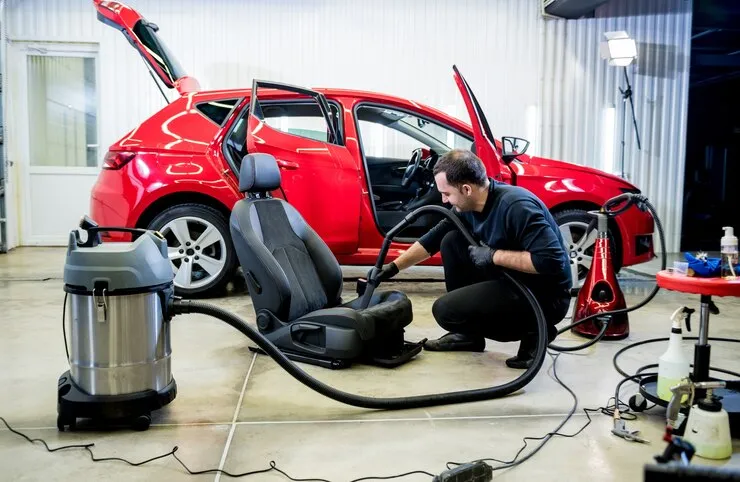
- Bucket (preferably two for the two-bucket method)
- Car shampoo (do not use household cleaners)
- Microfiber cloths for drying and cleaning
- Wash mitt (a gentle sponge or mitt specifically for cars)
- Detailing brushes for small crevices
- Vacuum cleaner for interior cleaning
- Glass cleaner (specific for automotive glass)
- Clay bar to remove dirt particles
- Car wax or sealant to protect the paint
- Tyre and wheel cleaner
- Upholstery cleaner (if you have fabric seats)
- Leather cleaner and conditioner (for leather interiors)
Step 2: Start With the Exterior Wash
Making your automobile seem brand new once more starts with the outside wash. Here is the right approach:
- Rinse the Car
Eliminate loose debris and grime using a hose. Beginning with a rinse helps prevent paint damage when washing. - Use the Two-Bucket Method
The other bucket should have clean water for washing your wash mitt; the first should have soapy water. This approach stops dirt and scratches from spreading throughout the surface of the automobile. - Wash from Top to Bottom
Start cleaning the roof, then work your way down. This stops dirt from invading previously cleansed areas. For your paint, use a mild auto shampoo. - Scrub the Wheels and Tyres
Use another brush and a cleaner meant especially for wheels. Wheels require more care as they gather road dirt and brake dust. - Rinse and Dry
To get all the soap, completely rinse the automobile. Drying the surface with a microfiber towel will help to prevent wet marks. Before starting waxing, make sure the automobile is absolutely dry.
Step 3: Clay Bar Treatment
Tiny dirt bits might remain cling to the paint of your automobile even after cleaning. Here the clay bar finds use. One should apply this as follows:
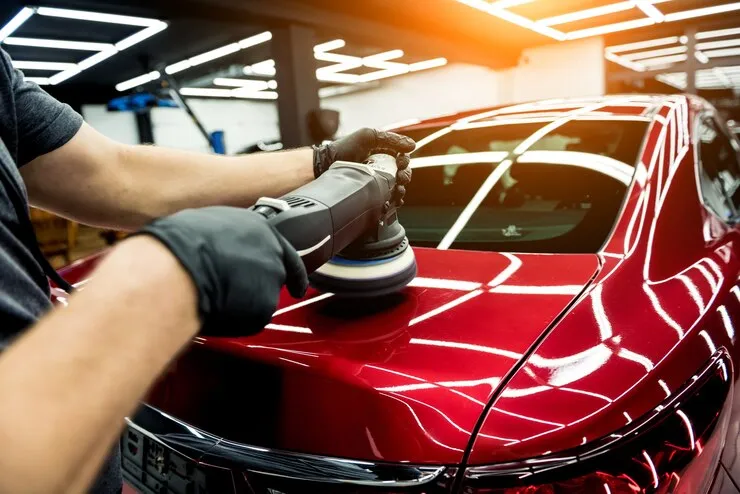
- Lubricate the Surface
Slick the surface with a clay bar lubricant or a detailing spray. - Rub the Clay Bar Over the Paint
Work the clay bar gently back and forth across the paint of the automobile. The clay will gather impurities caught in the clear covering. To keep the clay tidy, fold it over often. - Wipe Down the Surface
To eliminate any residue, wipe the surface with a fresh microfiber towel following the clay bar.
Step 4: Apply Wax or Sealant
One of the key stages in detailing is waxing your automobile. It not only polishes your automobile but also shields the paint from environmental deterioration.
- Choose Between Wax and Sealant
While a sealer provides longer-lasting protection, wax is more classic and delivers a great gloss. A sealant might be a better choice if you reside in the UK, where rain is regular as it usually lasts longer. - Apply in Circular Motions
Applying the wax or sealant in little circular movements with an applicator pad will Work in portions to guarantee you coat the entire automobile. - Let It Dry and Buff Off
As directed for the product, let the wax or sealant dry. Once dry, rub it with a fresh microfiber cloth. The automobile will now have a brilliant, protective covering.
Step 5: Clean the Glass
Don’t forget about your car’s windows! Clean windows not only look good but also improve your visibility while driving.
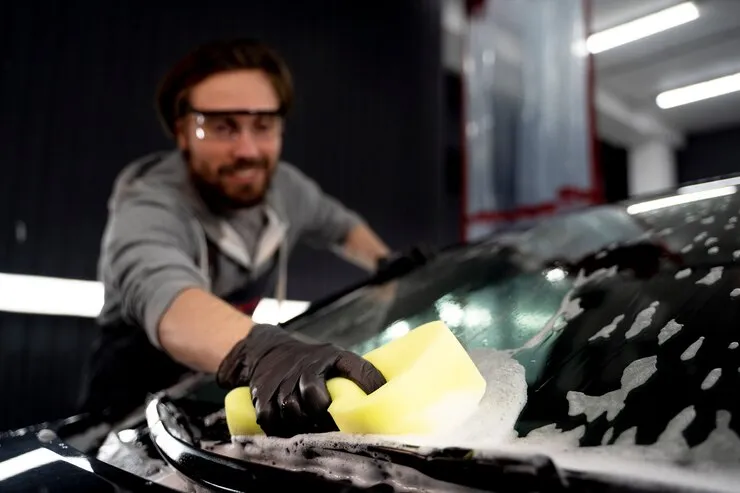
- Use an Automotive Glass Cleaner
Spray the cleaner directly on the glass or onto a microfiber cloth to avoid overspray. Wipe the windows in a vertical and horizontal motion to avoid streaks. - Pay Attention to the Edges
Make sure to clean the edges of the windows where grime tends to collect. You can also roll down the windows slightly to clean the top edge.
Step 6: Detail the Wheels and Tyres
Your wheels and tyres need special care as they often collect the most dirt and grime.

- Use a Tyre Cleaner
Spray the tyre cleaner onto the rubber and scrub with a brush. This will help remove any dirt and old dressing. - Apply Tyre Dressing
After cleaning, apply a tyre dressing product to give the tyres a deep black shine. This will also protect them from cracking. - Clean the Wheels
Use a wheel cleaner and a soft brush to remove brake dust and grime. Make sure to reach all the small spaces in the wheel’s design.
Step 7: Clean the Interior
Now that the exterior is sparkling, it’s time to focus on the inside. A clean interior can make a big difference in the overall feel of your car.
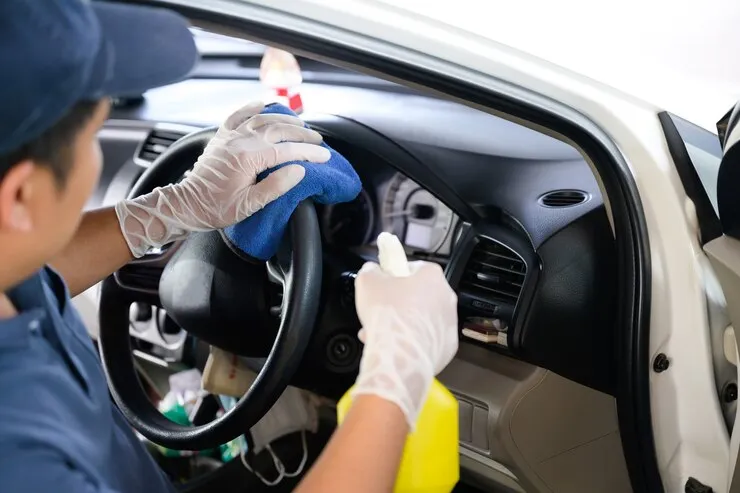
- Vacuum Thoroughly
Start by vacuuming the seats, carpets, and floor mats. Use different attachments to get into the crevices and tight spaces. - Wipe Down Surfaces
Use a microfiber cloth to wipe down the dashboard, door panels, and center console. You can use an interior cleaner for more stubborn dirt or stains. - Clean the Upholstery
If you have fabric seats, use an upholstery cleaner to remove any stains or dirt. For leather seats, use a leather cleaner and conditioner to maintain the softness and prevent cracking. - Deodorize
To give your car a fresh smell, use a deodorizer or a car-specific air freshener. Be careful not to use anything too strong as it can be overwhelming in a confined space.
Conclusion
Home auto detailing may be a fun and fulfilling hobby. Following the detailed step-by-step advice we have provided will help you to efficiently clean and revitalise your car so it feels and looks brand new once again.
Recall the main actions are cleaning the inside, washing the outside, polishing surfaces, and paint protection. Professional-level outcomes are within reach with a little time and effort without straying from budget.
Don’t hesitate to personalise your approach of detailing. Use materials designed for your vehicle and take your time to guarantee every nook and cranny is clean. Regular detailing will assist your automobile retain its worth over time in addition to maintaining it looking fantastic.
FAQs
What’s the best time to detail a car?
The best time to detail a car is on a cloudy day or in the shade. Direct sunlight can cause water spots and make it harder to apply wax and polish evenly.
How often should I detail my car?
It’s recommended to detail your car every 3-4 months. However, regular maintenance like washing and cleaning the interior should be done more frequently to keep your car in top shape.
Can I use household products to clean my car?
It’s best to avoid household cleaning products, as they can be too harsh for your car’s paint and interior materials. Always use products specifically designed for cars.
Do I need to polish my car every time I detail it?
Polishing isn’t necessary every time. You can polish your car once or twice a year to remove scratches and swirl marks, but regular washing and waxing are more important for maintenance.
What’s the difference between wax and sealant?
Wax provides a glossy shine but tends to wear off faster, especially in rainy weather like the UK often experiences. Sealants last longer and offer better protection, though they might not give the same deep shine as wax.

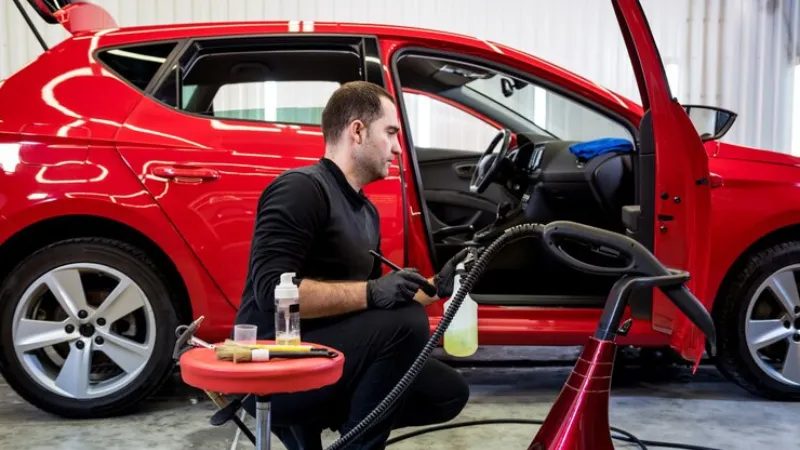
 Blog
Blog